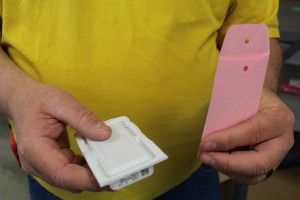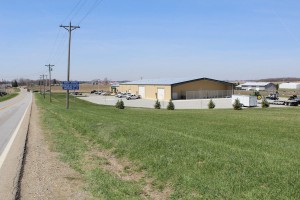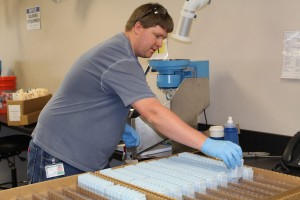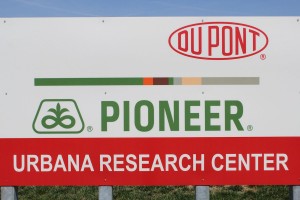(Farm and Dairy was informed June 12 that Pioneer plans to close the recently opened Urbana research location. This announcement was made post-press. The company is working to offer other positions to employees and keep its seed research in-state. The company states: “Through a process of review, Pioneer will further align talent and technology with highest potential initiatives, which will result in a slight level of employee reductions.”)
URBANA, Ohio — Today’s corn grower has hundreds of hybrids to choose from, thanks to advanced genetics and research. Varieties are available for every intended use of corn, and for different regions and climates across the world.
But before even one variety gets to the shelf, so-to-speak, it must first undergo a rigorous research process that advances only the best.
DuPont Pioneer, among the nation’s largest producers of hybrid seeds, opened a new research facility in December 2012, in Champaign County, that helps bring more of that rigorous research to Ohio and the East.
Known as the Urbana Research Center, the 25,000 square-foot facility is where corn seeds for Ohio research and test plots are packaged, counted and stored for planting.
The seeds tested in Ohio are bred and harvested across the United States and Canada, including Indiana, Michigan and Pennsylvania, and shipped to the Urbana plant to be sorted and planted.
Making the cut
Less than 1 percent of tested hybrid seeds make it to the commercial market — and those that do have a long journey — often two to six years, before they get approved for commercial use.
“Research is a big funnel,” with numbers that get “smaller and smaller,” the further along, said Rebekah Peck, a communications manager for Pioneer.
Peck, along with Senior Research Associate Joseph Stull, showed Farm and Dairy the new facility in April.
Most noticeable are the seed packets — stack after stack of tiny paper packets that contain about 80 seeds per packet. Each packet can plant two rows, 17.5 feet long, at normal row spacing and planting rate.
Packaging staff meticulously examine the seeds individually, and make sure they are packaged correctly.
Planting seeds
The ground where they are planted is leased and the first year of research helps to weed out the poorest performing varieties. The plots are analyzed throughout the growing season, at least once every week to two weeks, for things like stalk strength and height, ear height and development, and most importantly: yield.
“Yield is most important,” said Stull. “You could have the best stand (and) all of that, but if it doesn’t yield, it’s not going to advance.”
Pioneer leases and operates test plots across the state, as well as about a 7-acre test plot directly next to the Urbana facility.
Seeds that make it through the first round of research move on to something called Pioneer IMPACT (Intensively Managed Product Advancement Characterization), which means they will be planted and tested directly into farmers’ fields.
This step allows farmers and researchers to compare the new varieties alongside existing ones, and in the same soil conditions and with the same farming practices a farmer uses.
True test
This gives Pioneer and the farmer a truer look at yields and overall results, Peck said, while showing the grower how the variety will work on his own farm. Researchers from the Urbana facility plant corn into about 108 acres of farmers’ fields.
But even at the IMPACT stage, varieties are reduced and eliminated, until only the top few percent are made commercially available.
If a plot is planted with seeds that are not yet approved for the market, the remaining fodder is ground up and returned to the ground, to ensure the genetics of that variety do not survive.
Planting is usually started about the end of April. Conditions must be ideal, because if not, there’s usually not enough seed for replanting.
During planting, research staff sit on the back of specially designed research planters, opening and pouring the seed packets into the planter.
It’s a slow and often tedious process, but one that has improved. For example, researchers are in the process of 
Staying competitive
The seed business is highly competitive, and proprietary seeds are typically planted in the middle of fields, where they are protected from eyesight.
Even though corn has come a long way as a crop — doubling in yield many times the past 200 years — there is an ever-present demand for new varieties and better performance.
Stull said the “changing years and changing environments” are what’s driving the need for more seed. Most recently, for example, farmers have experienced extreme weather events from record rain to record drought, and they’re also using newer and better planting and tillage technology.
And, world population is growing, which means more demand for food. Experts have long predicted a world population of 9 billion by 2050, and that means more demand for advanced seed.
“It’s amazing (corn’s yield), but it’s going to need to be even more amazing if we want to meet those goals,” Peck said. “And I think that’s not unique to Pioneer — I think that’s across the industry.”
Growing the industry
As the demand for better seed continues, so does the demand for well-trained people who develop the seeds.
In 2013, Pioneer donated $5,000 to the newly formed Global Impact STEM (Science, Technology, Engineering and Mathematics) high school, located at Clark State Community College in Springfield. The funds were provided so students could participate in ag-related field trips.
“There’s such a need to have those folks coming out of school right now that want those jobs,” Peck said, adding this experience also helps ensure future job seekers are “well-trained and have an interest and passion for agriculture.”
Pioneer also partners with the Ohio Soybean Council for the Soybean Biotech Academy, which helps educate high school teachers about environmental and ag sciences. This summer, Pioneer will host 30-40 Ohio teachers, who will participate in lab work and educational sessions.














